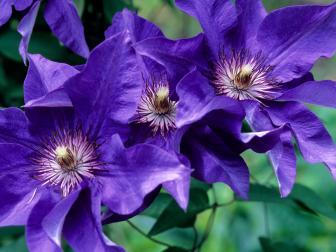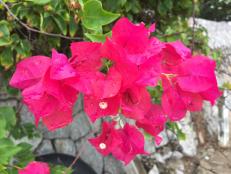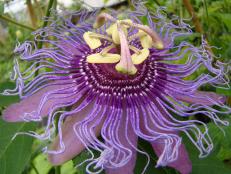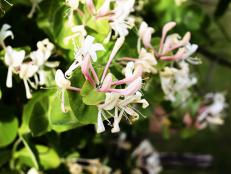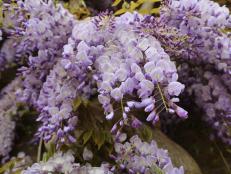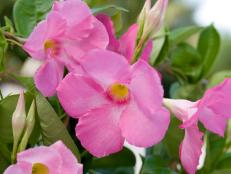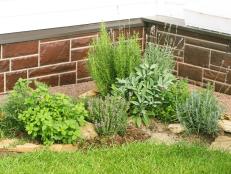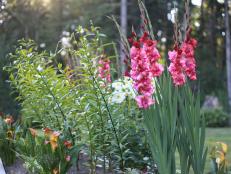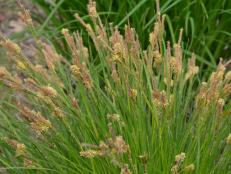How to Grow Clematis Vine
Give your garden the royal treatment by growing clematis, the queen of climbers.
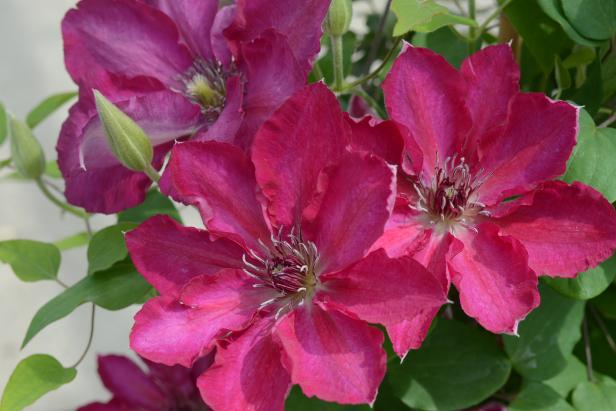
BaileyNurseries.com
Garland Tekla clematis opens 4- to 5-inch-wide flowers non-stop from early summer through fall. It's hardy in Zones 4 to 9.
For sheer beauty and flower power, it's tough to beat clematis. Once established, perennial clematis vines deliver beautiful blooms that vary in size and appearance. Some clematis varieties unfurl large 6- to 10-inch flowers, while others open dainty blossoms, double blooms or bell-shaped flowers. Vines can be evergreen or deciduous, losing their leaves before winter.
Plant breeders have been working overtime with clematis and the result is an explosion of different varieties available at most garden centers. You'll find fragrant clematis, reblooming clematis and traditional favorites, like purple Clematis jackmanii, evergreen Clematis armandii and native Clematis virginiana. Some clematis vines blossom in spring, like Clematis montana, while others, such as sweet autumn clematis (C. terniflora), fill fall scenes with bowers of blooms.
17 Clematis Varieties 17 Photos
We dig clematis — and know you will too. Discover exciting flower colors and plant forms, including knee-high shrubs and classic trellis-climbing clematis varieties.
Once flowers fade, clematis plants form fuzzy eye-catching seedheads that add more interest to the autumn garden. Depending on variety, clematis vines are hardy in Zones 4-7 and grow anywhere from 5 to 80 feet tall. Some clematis plants form more of a shrub in the garden while others provide a gorgeous top-dressing for a retaining wall. Clematis care is generally easy — these gorgeous bloomers are low maintenance plants once they're established.
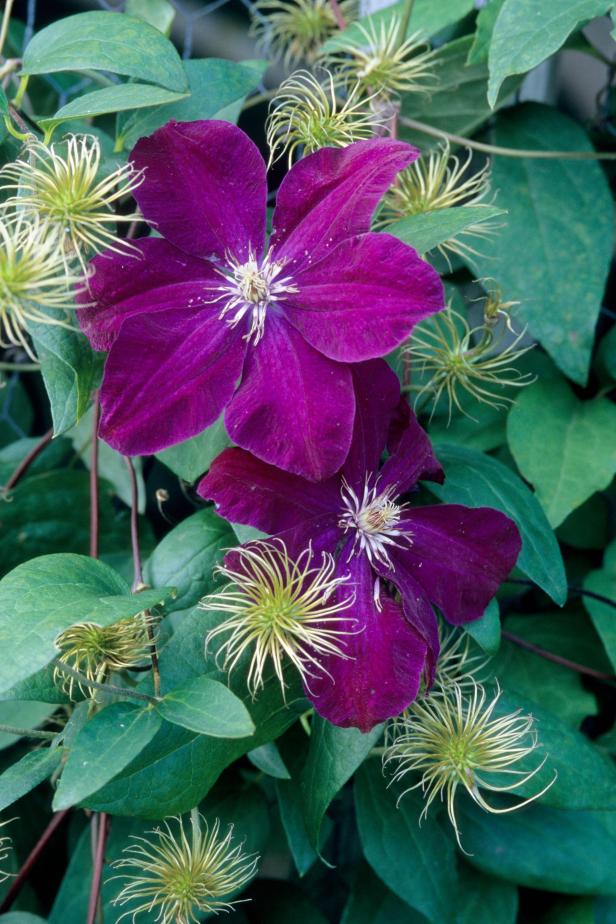
BaileyNurseries.com
When clematis flowers fade, they form quirky mophead seedheads that look like something out of a Dr. Seuss story. 'Rouge Cardinal' clematis grows best in full sun. Vines grow 10 to 12 feet tall and up to 4 feet wide. It's hardy in Zones 3 to 10.
Choosing a Clematis Vine
The main thing to consider when selecting a clematis variety is how large the vine will grow, flower color and form. At the nursery or garden center, look for a plant that appears healthy with green leaves and a few actively growing vines in the pot. If you want a particular flower color, choose a plant in bloom to make sure you get the right variety.
Clematis plants are slow growers. The old garden adage "first year sleep, second year creep, third year leap" is often applied to clematis vines. To shorten the wait for a stunning flower show, choose the healthiest, biggest clematis plant you can afford. Typically plants in a quart or gallon-size pot are two years old and will take off strongly once planted. You may still experience the adage of sleep, creep, leap, but when the leap occurs and vines burst into bloom, you'll have a substantial plant with the flowers you've dreamed about.
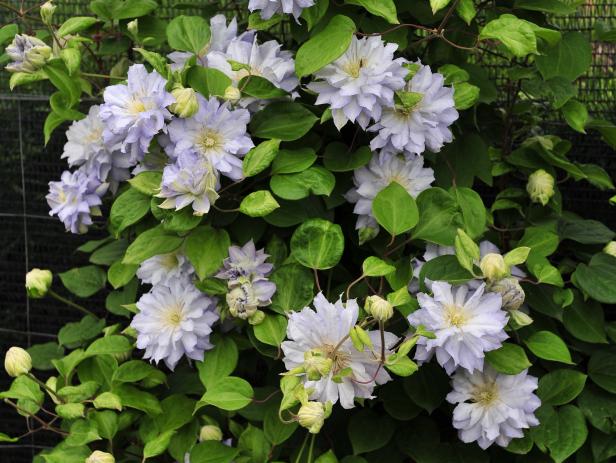
ProvenWinners.com
'Diamond Ball' clematis unfurls cool white-blue double flowers. It's hardy in Zones 4-9.
Where to Plant Clematis Vines
Most clematis varieties thrive in full sun — that means at least six hours of sun a day, except in hottest regions where protection from sizzling afternoon sun is needed. While most clematis vines need sun to flower well, they also prefer shade on their roots. The other garden adage that's said for clematis is, "Flowers in the sun, roots in the shade."
To achieve this specific mix of growing conditions, tuck clematis vines beside a shrub and let stems wend their way through the shrub to bloom in the sun. Classic clematis shrub companions include roses, lilacs, elderberries with colorful leaves and hydrangeas for shade-tolerant clematis. You can also pair clematis with clump-forming, low-growing perennials, such as dayliles, shrubby sedum or veronica. The perennial helps shade the soil where clematis roots grow. A 2-inch-thick mulch layer also shades clematis roots effectively.
Clematis varieties exist that flower well in part to full shade. These include pale lavender 'Silver Moon,' lilac-striped mauve 'Nelly Moser,' pale yellow 'Guernsey Cream' and pink striped 'Bees' Jubilee.' In full sun, the lighter hues of these blossoms tend to bleach out.
The ideal soil for growing clematis vines is fertile and well-drained. When choosing where to plant your clematis vines, watch for spots that might create warm microclimates, such as beside a stone wall, patio or driveway. In these areas, hardscape surfaces can retain heat and transfer it to surrounding soil. You can grow clematis successfully in these locations as long as you monitor soil moisture, and water before the soil dries out completely.
Planting Clematis
When planting clematis, dig a hole that's slightly larger and deeper than the container the plant is in. Clematis is one of the few plants you want to plant deeply, actually burying 2 to 6 inches of the above-ground stems. This is a relatively new practice with clematis, but it helps plants avoid a dreaded clematis disease known as clematis wilt. Remove all leaves on the portion of stems that will be underground. The buried stems will produce roots.
Clematis wilt disease only affects aboveground parts of a clematis, so by planting it deeply, you're creating a stronger root system that can help ensure your plant survives if wilt develops. Mix aged compost or well-rotted leaf compost into the soil you remove from the planting hole. This creates the type of fertile, well-drained soil that helps clematis vines thrive.
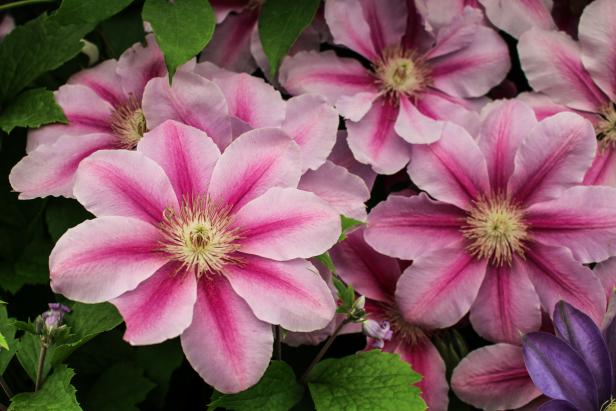
'Bees Jubilee' features soft pink petals with dark pink striking the center of each petal. Brown anthers with yellow bases add an incredible contrast to this perennial.
Provide a Clematis Trellis
Some clematis varieties form small shrubs, but many are vines that are born to climb. A clematis climbs by wrapping its leaf stems around a support. Leaf stems are small and cling best to supports that are less than a half-inch in diameter. To train a clematis to climb along a split rail or picket fence, you need to provide a wire or twine support to give leaf stems something to grab.
12 Great Garden Trellises
Add support and style to your landscape design with these beautiful garden trellises.
Sometimes gardeners cover the lower third of a clematis trellis with a piece of wire fencing or netting to give vine stems a leg up, so to speak. Twine also works well to help clematis climb. During the first year a clematis is growing, it's a good idea to train vines to grow horizontally by tying stems to a support. This is especially important if you're growing a clematis along a fence.
Clematis Care
Watering
The first year after planting, keep a close eye on plants and water regularly to help roots establish. Aim to give clematis vines roughly 1 inch of water a week, either through irrigation or rainfall. Once clematis vines are established, they're really low maintenance plants. Your main tasks will include mulch replacement to maintain a 2-inch depth for soil cooling and regular watering during dry spells.
Fertilizing
At planting time, mix compost with soil you remove from the planting hole to help nourish your newly planted clematis vine. You can also use an inorganic slow release fertilizer with low numbers, such as 4-3-2. Always follow instructions on the fertilizer label. For established clematis, like a healthy Clematis virginiana or Clematis jackmanii, feed plants in spring and fall with slow-release plant fertilizer. In spring as new growth begins, feed all clematis vines with a shovelful of compost or granular organic fertilizer.
Pruning
The trickiest part of clematis care is pruning. Trimming vines is important. When done correctly, it keeps plants healthy and flowering strongly. With all clematis vines, you can remove dead, damaged or diseased stems at any time. To prune plants to maintain healthiest growth, reduce size or promote the most flower buds, you need to know what kind of clematis vine you have.
How To Prune Clematis
Learn what you need to know to keep your clematis vine looking its best.
- For clematis varieties that flower in early spring, prune as soon as possible (if needed) after flowering but before July. This group includes Clematis montana, Clematis armandii and Clematis alpina.
- For clematis varieties with large flowers that open in midspring, cut plants back to curtail size after flowering. This group includes 'The President,' 'Henryi,' 'Nelly Moser' and 'Ramona.'
- For clematis varieties that flower in late summer on new stems, cut plants back to 6 to 24 inches tall in late winter or early spring. This group includes Clematis jackmanii, 'Ernest Markham,' Clematis viticella, Clematis texensis and Clematis integrifolia hybrids.
Common Clematis Problems
For the most part, clematis vines are carefree additions to the garden. Once they're established, they grow strongly and flower reliably. But occasionally, you might have an issue. Here are a few common problems you may encounter:
- No flowers. Clematis vines that are too young don't usually bloom. Other reasons plants may lack flowers are inadequate sunlight and overfertilizing, which is likely if you have lots of lush leaves. Also if you prune at the wrong time, you might inadvertently remove flower buds.
- Chewed leaves. Japanese beetles and several butterfly caterpillars like to munch on clematis leaves and flowers. Rabbits are notorious for feasting on stems in winter. In wintry regions, protect clematis vines in winter by surrounding stem bases with a wire collar.
- Diseases. Clematis vines are susceptible to various fungal diseases, including fungal wilt, powdery mildew and botrytis gray mold. Mottled yellow leaves with green veins are often due to tomato ringspot virus and yellow spores embedded in leaves are rust. Clematis wilt is a common problem that causes apparently healthy vines to wither and turn black overnight. Whenever your clematis vine has a problem, the right course of action is to get the disease properly identified so you can discover treatments. Your local extension office or a trusted garden center can usually advise you.







